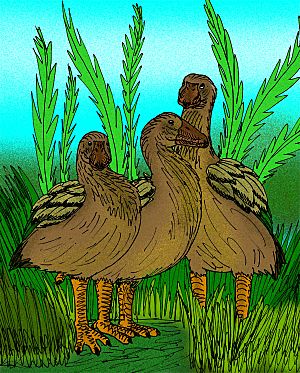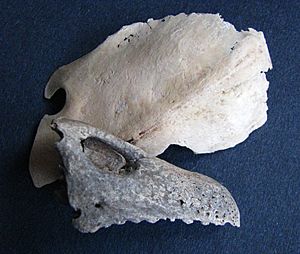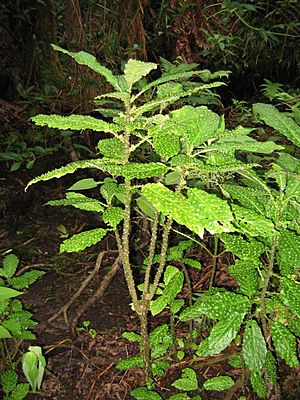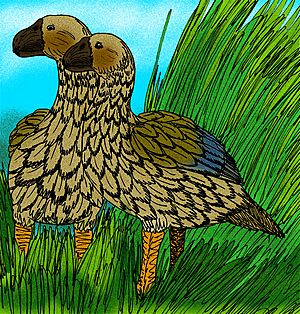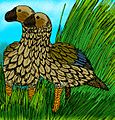Moa-nalo facts for kids
Quick facts for kids Moa-naloTemporal range: Holocene
|
|
|---|---|
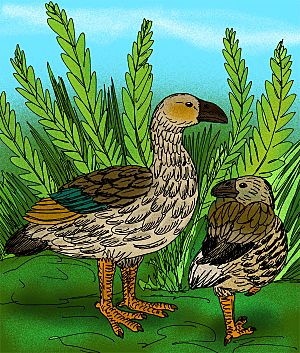 |
|
| Artist's conception of Thambetochen chauliodous, and Ptaiochen pau | |
| Scientific classification |
|
| Kingdom: | Animalia |
| Phylum: | Chordata |
| Class: | Aves |
| Order: | Anseriformes |
| Family: | Anatidae |
| Subfamily: | Anatinae |
| Tribe: | †Thambetochenini |
| Genera | |
|
Chelychelynechen |
|
The moa-nalo were a group of unusual, goose-like ducks. They are now extinct, meaning they no longer exist. These birds lived on the larger Hawaiian Islands in the Pacific Ocean. However, they were not found on the island of Hawaiʻi itself.
Moa-nalo were the main herbivores (plant-eaters) on most of these islands. They disappeared after humans started settling there.
Contents
Discovering the Moa-Nalo
The moa-nalo were unknown to science for a long time. They had already died out before Captain James Cook arrived in Hawaii in 1778.
Their old bones, called subfossil remains, were found in the early 1980s. These bones were discovered in sand dunes on the islands of Molokaʻi and Kauaʻi. Later, more bones were found on Maui, Oʻahu, and Lānaʻi. They were found in places like lava tubes, old lake beds, and sinkholes.
So far, scientists have found four different species (types) of moa-nalo. These species belong to three different genera (groups of species):
- Chelychelynechen quassus: This is the turtle-jawed moa-nalo from Kauaʻi.
- Ptaiochen pau: This is the small-billed moa-nalo from Maui.
- Thambetochen xanion: This is the Oʻahu moa-nalo from Oʻahu.
- Thambetochen chauliodous: This is the Maui Nui large-billed moa-nalo. It lived on Maui, Lānaʻi, and Molokaʻi (an area called Maui Nui).
What Moa-Nalo Looked Like
The name Chelychelynechen means "turtle-jawed goose." This bird had a big, heavy beak that looked like a tortoise's beak. The other two groups, Thambetochen and Ptaiochen, had special serrations in their beaks. These were like small, saw-like edges, similar to the "pseudoteeth" found in merganser ducks.
All moa-nalo species were flightless. This means they could not fly. They were also quite large, weighing about 4 to 7.5 kilograms (9 to 16.5 pounds) on average.
How Moa-Nalo Evolved
Scientists found traces of mitochondrial DNA in some moa-nalo fossils. This special DNA helps scientists understand how living things are related. They compared it to the DNA of living duck species. This helped them figure out where moa-nalo fit in the duck family, called Anatidae.
Many scientists thought moa-nalo might be related to large geese, like the nēnē (Hawaiian goose) that still lives today. But the DNA showed something different. Moa-nalo were actually related to the dabbling ducks. This group includes common ducks like the mallard.
The DNA tests are not yet clear enough to show their exact relatives within the Anas group. However, studying where animals live (called biogeography) suggests something interesting. Their closest living relative might be the widespread Pacific black duck.
Moa-Nalo's Role in Nature
The unusual shape and size of the moa-nalo were important for their role in the ecology (how living things interact with their environment) of ancient Hawaiʻi. Scientists studied coprolites (fossilized droppings) from Thambetochen chauliodous. These were found in a cave on Maui. The study showed that these birds were folivorous, meaning they ate leaves. They especially ate fronds from ferns in dry shrub or mesic forest habitats. This fits with the shapes of their beaks.
This means moa-nalo were the main browsers (animals that eat leaves and twigs) on the islands. They filled the niche (role in nature) that mammals like goats and deer usually fill. They were also like the giant tortoises found on the Galápagos Islands and other archipelagoes.
Some Hawaiian plants, like those in the Cyanea group, have sharp spines on their leaves and young stems. This is unusual for island plants, which often lose such defenses. These spines likely evolved to protect the plants from being eaten by moa-nalo. The loss of moa-nalo has changed the ecology of the Hawaiian Islands today.
Like other island taxa (groups of living things) from places like Mauritius, New Zealand, and Polynesia, moa-nalo were not used to mammals. This made them easy targets for human hunters. They were also easily hunted by animals that humans brought to the islands and that became feral (wild), such as domestic pigs.
Images for kids
See also
 In Spanish: Moa-nalo para niños
In Spanish: Moa-nalo para niños


